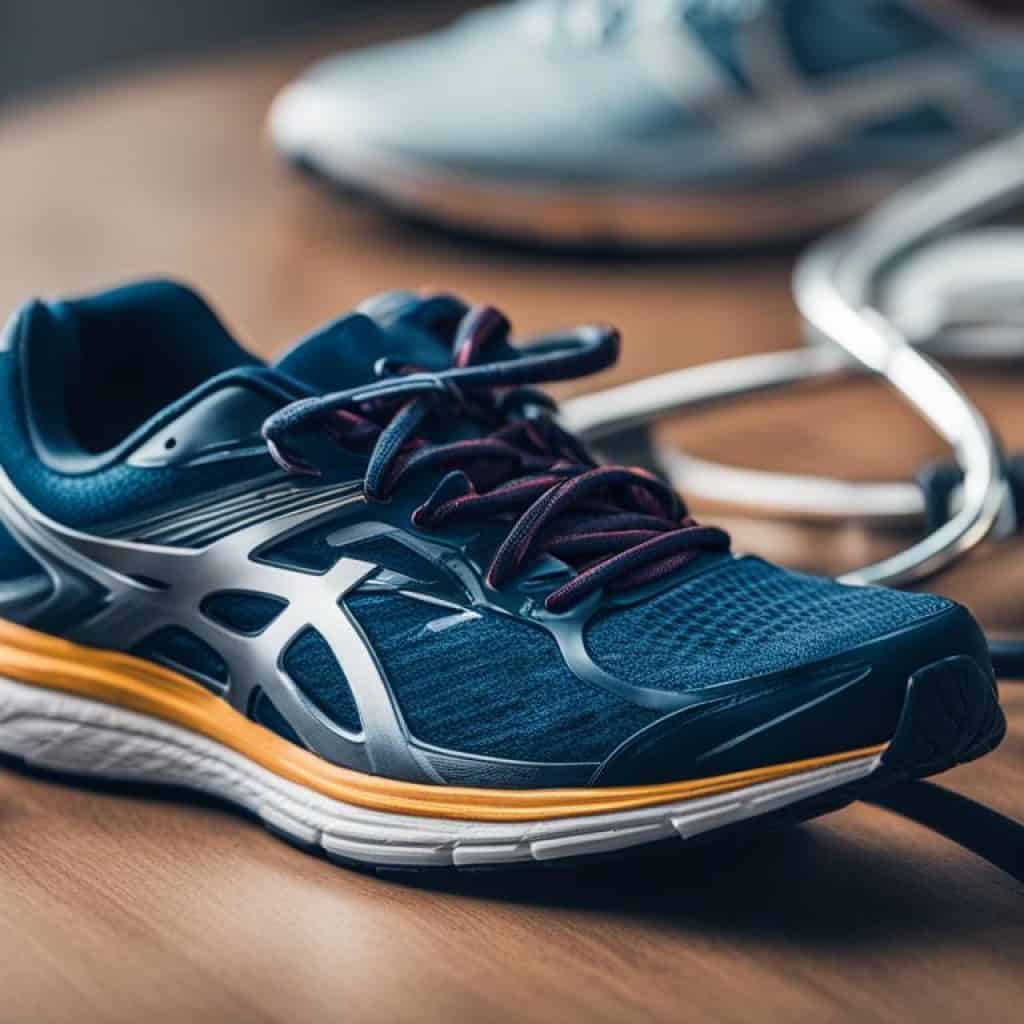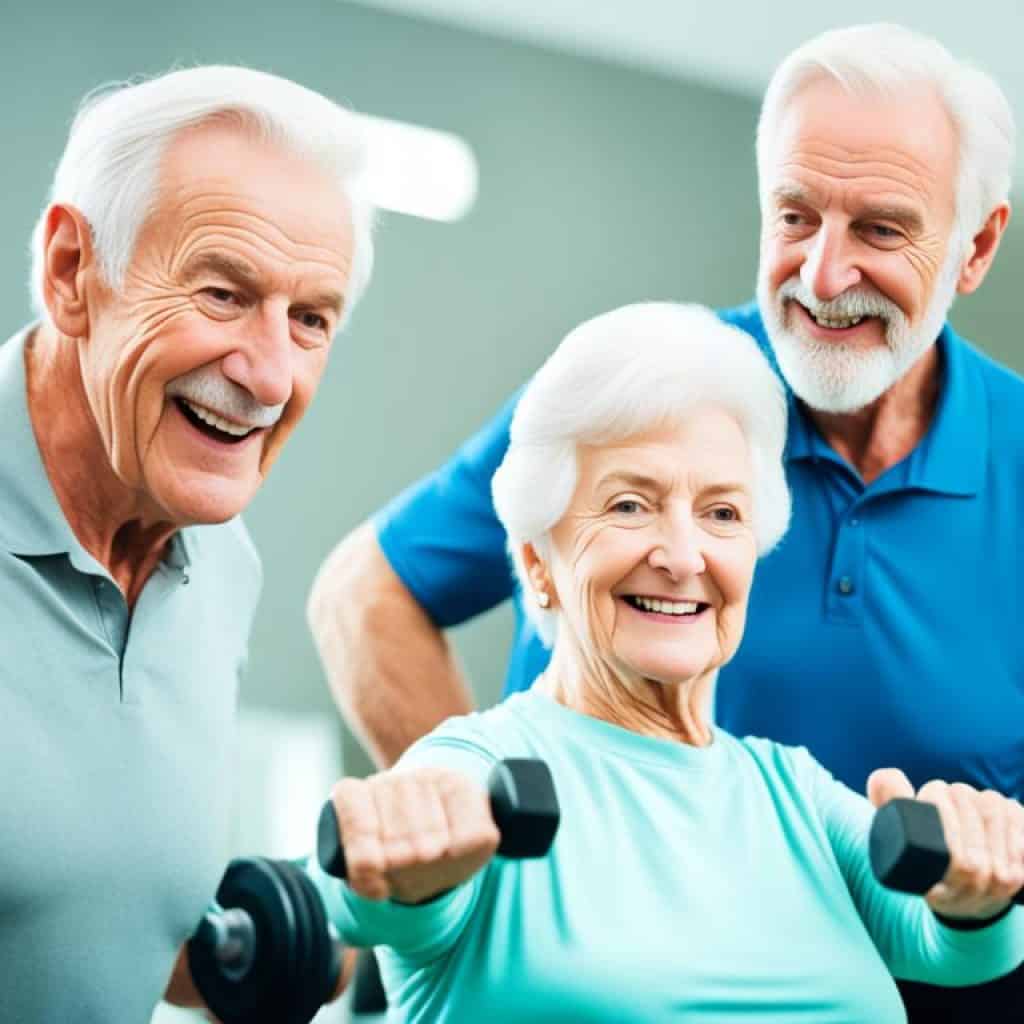Have you ever looked in the mirror and longed to feel vibrant, energetic, and confident in your own skin? I think we can all relate to that desire for a healthier and more fulfilling life. As we age, our bodies go through changes, and it’s easy to fall into the trap of thinking that it’s too late to get in shape. But let me tell you, it’s never too late to make a positive change.
My name is Sarah, and I’m here to share my personal journey of getting in shape after 50. Like many others, I found myself at a crossroads, feeling tired, out of shape, and wondering if I would ever regain my vitality. But I made a decision, a commitment to myself, to prioritize my health and fitness.
Starting this journey wasn’t easy. There were days when I struggled to find the motivation, when doubts crept in and whispered that I was too old or too busy to make a change. But I pushed through, and I’m so glad I did.
Now, at 55, I can confidently say that getting in shape after 50 is more than just a physical transformation – it’s a mindset shift, a rediscovery of the incredible strength and resilience that lies within each and every one of us.
Through trial and error, I’ve learned valuable lessons and discovered fitness routines that work harmoniously with my body and lifestyle. I’ve experienced firsthand the incredible benefits of regular exercise, proper nutrition, and a positive mindset.
So, if you’re ready to embark on your own journey towards health and vitality, join me as we explore the world of fitness for seniors, exercise routines for older adults, and the keys to staying active after 50. Together, we can overcome any obstacles and create a life full of energy, strength, and joy.
Key Takeaways:
- Getting in shape after 50 is a journey that is never too late to start.
- Committing to your health and fitness is a powerful decision that can lead to transformative results.
- It’s important to find a fitness routine that works for your body and lifestyle.
- Regular exercise, proper nutrition, and a positive mindset are key to achieving and maintaining fitness goals.
- Embrace the journey and enjoy the incredible benefits of a healthier and more vibrant life.
The Importance of Finding Enjoyable Exercise
When it comes to getting in shape after 50, one of the most crucial factors is finding an exercise routine that you truly enjoy. Engaging in enjoyable physical activities increases the likelihood of sticking with them, ensuring long-term fitness and overall well-being.
One way to determine which fitness activity suits you best is by taking a quiz specifically designed for seniors. This quiz can help narrow down your options by considering your interests, preferences, and physical abilities. By identifying activities that align with your preferences, you can embark on a fitness journey that will not only benefit your health but also bring you immense satisfaction.
Reading stories of individuals who have found their passion for exercise after 50 can also be motivating and encouraging. These personal accounts showcase the transformative power of finding an enjoyable exercise routine. They can provide inspiration, ignite the desire to try new activities, and reaffirm that age is no barrier to staying fit and active.
Remember, exercise should not be seen as a chore or obligation, but rather as an opportunity for self-care and personal growth. By embracing the joy and fulfillment that an enjoyable exercise routine brings, you’ll be more motivated to prioritize your health and well-being.
Achieve Your Fitness Goals with Pleasure
Enjoyable exercise not only helps you stay motivated but also allows you to achieve your fitness goals in a fulfilling and sustainable way. Whether it’s dancing your way to better cardiovascular health or finding peace and serenity through yoga, the right activity can transform your fitness journey into a positive and enjoyable experience.
Discover the exercise that brings you joy, and you’ll discover a world of endless possibilities for staying fit and healthy after 50.
Gradually Building Up Your Exercise Routine
When it comes to getting fit after 50, it’s important to start with a gradual approach to avoid overexertion and injury. By gradually building up your exercise routine, you’ll give your body time to adjust and adapt to the increased physical demands. One effective way to ease into regular physical activity is by starting with a 10-minute workout.
Begin by dedicating just 10 minutes of your day to exercise. This can be as simple as going for a brisk walk around your neighborhood or engaging in light stretching exercises. The key is to get your body moving and your heart rate up, even if it’s for a short period.
Remember, consistency is key. Starting with a 10-minute workout may not seem like much, but it’s a great first step towards building a regular exercise routine. As your fitness level improves and you feel comfortable, gradually increase the duration and intensity of your workouts.
Walking to get fit after 50 is an excellent choice for seniors. It’s a low-impact activity that puts minimal stress on your joints while providing a great cardiovascular workout. Regular walking can help improve your cardiovascular health, strengthen your muscles, and increase your endurance.
| Benefits of Walking after 50 |
|---|
| Improves cardiovascular health |
| Strengthens muscles and bones |
| Helps manage weight |
| Boosts mood and mental well-being |
âWalking is a simple yet powerful exercise that can greatly improve your overall health and well-being. It’s accessible, low-impact, and can be done almost anywhere. So put on your walking shoes and start taking steps towards a healthier and fitter you!â
Walking as a form of exercise can be done alone or with friends, making it a social and enjoyable activity. You can explore new neighborhoods, parks, or walking trails together, making your workouts more engaging and fun. Plus, having a walking buddy can provide motivation and accountability.
Remember to wear comfortable and supportive shoes, maintain good posture, and start with a pace that feels comfortable for you. Gradually increase your walking distance and speed as your fitness level progresses. Aim for at least 30 minutes of brisk walking most days of the week to reap the full health benefits.
Summary
Building up your exercise routine gradually and starting with a 10-minute workout can set a solid foundation for your fitness journey after 50. Walking is an excellent choice for seniors, providing numerous health benefits such as improved cardiovascular health, stronger muscles and bones, weight management, and enhanced mood. So lace up your walking shoes, step outside, and embrace the wonders of walking to get fit after 50!
The Power of Exercising with Friends or Groups
Exercising with friends or joining exercise groups can provide a powerful boost to your fitness journey. Not only does it add fun and enjoyment to your workouts, but it also creates a positive and supportive environment that can keep you motivated and accountable. Whether you prefer the energy of group classes or the camaraderie of exercising with friends, there are plenty of options to explore.
One great way to incorporate social exercise into your routine is by joining a walking group. Walking is a low-impact exercise that is suitable for seniors of all fitness levels, and it offers a range of health benefits including improved cardiovascular health, stronger bones, and reduced risk of chronic diseases. Walking with a group not only provides companionship but also adds a competitive element and motivation to reach your fitness goals.
If you’re looking for a more interactive and team-focused experience, consider activities like walking rugby. This modified form of rugby is designed to accommodate all skill levels and focuses on walking rather than running. It provides a fun and inclusive way to engage in physical activity while enjoying the camaraderie of a team sport.
Exercising with friends or joining exercise groups can turn your fitness journey into a social experience. It allows you to connect with others who share similar goals and interests, and it can provide a support system that encourages you to push your limits and have fun along the way.
Benefits of Exercising with Friends or Groups:
- Motivation and accountability: When you have workout buddies, you’re more likely to stick to your exercise routine and achieve your fitness goals.
- Increased enjoyment: Exercising with friends or in groups can make your workouts more enjoyable and something to look forward to.
- Healthy competition: Group settings can create a healthy sense of competition, pushing you to challenge yourself and achieve new milestones.
- Socialization: Exercising with others allows you to meet new people, make friends, and build a supportive network.
So, why not invite a friend to join you for a workout or explore local exercise groups in your community? Embrace the power of exercising with friends or groups and discover a whole new level of motivation, enjoyment, and fitness success.
Making Exercise a Priority
To ensure you always have time for exercise, it’s essential to plan it into your schedule. Treat it as a priority and dedicate specific time slots for physical activity. This will help make it a consistent habit and part of your daily routine.
Setting aside time for exercise allows you to prioritize your health and well-being. By incorporating exercise into your daily schedule, you are more likely to follow through and make it a regular part of your routine. Whether it’s a morning walk, a lunchtime workout, or an evening yoga session, finding a time that works best for you is key.
Consider using a planner, calendar, or a mobile app to schedule your exercise sessions. Set reminders to ensure you don’t forget and stick to your plan. Treat these dedicated time slots for exercise as non-negotiable, just like any other important appointment or commitment in your life.
âThe only bad workout is the one that didn’t happen.â – Unknown
Making Exercise a Habit
Transforming exercise into a habit requires consistency and repetition. Start by setting small, achievable goals and gradually increase the intensity and duration of your workouts as you progress. Remember, every little step counts!
Find activities that you enjoy and that align with your interests. This will make it easier to stay motivated and committed to regular exercise. Whether it’s walking in nature, dancing to your favorite tunes, or practicing yoga, choose exercises that bring you joy.
Here are some tips to help you make exercise a habit:
- Start with manageable goals and gradually increase the difficulty.
- Be patient with yourself and celebrate small victories along the way.
- Find an exercise buddy or join a group to stay motivated and accountable.
- Track your progress to see how far you’ve come.
Incorporating physical activity into your daily life not only improves your physical well-being but also boosts your mood, reduces stress, and enhances overall quality of life.
Setting Achievable Fitness Goals
Setting exercise targets is a powerful way to stay motivated and focused on your fitness journey. By having specific goals in mind, you can track your progress and celebrate your achievements along the way. Whether you want to increase the duration of your walks or train for an event, setting targets provides a clear direction for your workouts.
One effective goal for improving your fitness is to focus on walking for longer periods. Walking is a low-impact exercise that can be easily integrated into your daily routine. Start by aiming for a specific distance or duration, and gradually increase it over time. For example, you can set a target of walking for 30 minutes a day and then work your way up to an hour.
Another option is to train for a specific event, such as a charity walk or a local 5K run. Signing up for an event gives you a tangible goal to work towards and adds excitement to your fitness journey. It’s important to establish a training plan that includes both cardiovascular exercises and strength training to prepare your body for the event.
Remember, the key to setting achievable fitness goals is to make them realistic and attainable. Set targets that challenge you but are within your physical capabilities. Break your goals down into smaller milestones, and celebrate each milestone you reach. This will keep you motivated and inspired to continue pushing yourself.
“Setting goals is the first step in turning the invisible into the visible.”
â Tony Robbins
Sample Workout Goals:
| Goal | Description |
|---|---|
| Walk 10,000 Steps a Day | Track your steps using a pedometer or a fitness tracker and increase your daily step count gradually. |
| Complete a 5K Run | Follow a training plan that gradually increases your running distance and prepares you for the event. |
| Improve Flexibility | Incorporate stretching exercises into your routine and work towards achieving specific flexibility goals. |
| Perform Strength Training Twice a Week | Create a strength training plan that targets all major muscle groups and gradually increases resistance. |
By setting exercise targets, you can turn your fitness aspirations into achievable milestones. Remember to consult with a healthcare professional before starting any new exercise program, especially if you have pre-existing medical conditions.
Consult with Your Doctor Before Starting New Exercises
Before embarking on any new exercise program, it is crucial to consult with your doctor, especially if you have any pre-existing health conditions. Your doctor’s approval for exercise is essential to ensure your safety and well-being. They can provide valuable guidance and advice on exercise recommendations specific to your unique needs.
This is even more important if you have undergone heart bypass surgery. Following a heart bypass surgery, your doctor will be able to advise you on when it is safe to start exercising and recommend appropriate activities. Exercising after heart bypass surgery can aid in your recovery and improve your overall cardiovascular health.
Additionally, consulting with your doctor is vital for staying healthy in later life. As we age, our bodies may have more specific requirements and limitations. Your doctor can help determine what types of exercises are suitable for you, considering any age-related factors or chronic conditions you may have. They can also provide tips on how to modify exercises or incorporate necessary precautions to ensure your safety.
“Always consult with your doctor before starting any new exercise program, particularly if you have any underlying health issues or have recently undergone surgery. Your doctor’s approval for exercise is an important step towards maintaining your health and well-being.”
Finding the Right Exercise Program
Based on your specific circumstances, your doctor can guide you in choosing the most appropriate exercise program for your needs and goals. They may recommend a combination of cardio, strength training, and flexibility exercises to ensure overall fitness and a balanced approach to exercise.
Benefits of Doctor's Approval for Exercise
- Ensures your safety and well-being
- Provides guidance on suitable exercises for your unique needs
- Helps establish realistic fitness goals
- Offers advice on modifying exercises to accommodate any physical limitations
- Monitors and adjusts your exercise program as needed
Remember, your doctor’s approval for exercise is an essential step towards maintaining a healthy and active lifestyle. By working together with your healthcare provider, you can create a tailored exercise plan that promotes your well-being and helps you achieve your fitness goals.
| Benefits of Consulting with Your Doctor | Why it Matters |
|---|---|
| Personalized exercise recommendations | Ensure exercises are appropriate for your health condition and fitness level |
| Safety precautions | Reduce the risk of injury or exacerbating pre-existing conditions |
| Peace of mind | Exercise with confidence, knowing you have your doctor’s approval |
| Optimal health outcomes | Maximize the benefits of exercise for your overall well-being |

The Role of Nutrition in Getting Fit After 50
A healthy diet plays a crucial role in getting fit after 50. It is important to focus on consuming fresh, high-quality foods that provide the necessary nutrients for optimal health and fitness.
One key aspect of a healthy diet for seniors is incorporating lean sources of protein. Protein is essential for building and repairing tissues, maintaining muscle mass, and supporting overall health. Include sources such as poultry, fish, lean meats, eggs, dairy products, tofu, and legumes in your diet.
In addition to protein, dietary fiber is also important for seniors. Fiber aids in digestion, helps prevent constipation, and promotes a feeling of fullness, which can prevent overeating. Aim for a daily intake of at least 35 grams of fiber from sources like fruits, vegetables, whole grains, and legumes.
The Benefits of Lean Protein:
- Supports muscle growth and maintenance
- Aids in tissue repair
- Promotes satiety and prevents overeating
- Provides essential amino acids for overall health
The Benefits of Dietary Fiber:
- Improves digestion and prevents constipation
- Supports heart health and lowers cholesterol levels
- Helps control blood sugar levels
- Promotes weight management
Incorporating these nutrients into your diet can help you feel more satisfied, maintain a healthy weight, and support your fitness goals. Consult with a registered dietitian or nutritionist for personalized guidance and recommendations based on your specific needs and preferences.
“Eating a well-balanced diet that includes lean protein and dietary fiber is essential for seniors looking to get fit after 50. These nutrients provide numerous health benefits and play a crucial role in supporting overall well-being.”
| Food Source | Protein Content (per 100g) | Fiber Content (per 100g) |
|---|---|---|
| Chicken Breast | 31g | 0g |
| Salmon | 25g | 0g |
| Eggs | 13g | 0g |
| Greek Yogurt | 10g | 0g |
| Tofu | 8g | 2g |
| Quinoa | 4.4g | 2.8g |
The Benefits of Aerobic Exercise
Regular aerobic exercise is crucial for seniors looking to get fit after 50. It offers a wide range of benefits that can enhance overall health and well-being. By engaging in moderate-intensity cardiovascular exercises, you can improve your physical fitness, support weight management, and boost various aspects of your mental and emotional health.
Aerobic exercise, also known as cardio, involves activities that increase your heart rate, breathing rate, and circulation. This type of exercise helps strengthen your heart and lungs, promoting efficient oxygen delivery throughout your body.
When performed on a regular basis, aerobic exercise can:
- Burn calories and reduce body fat, aiding in weight management.
- Improve cardiovascular health, lowering the risk of heart disease and stroke.
- Enhance sleep quality, promoting restful and rejuvenating rest.
- Boost emotional well-being, reducing stress and anxiety levels.
- Enhance cognitive function, supporting mental sharpness and memory.
To reap these benefits, aim for at least 150 minutes of moderate-intensity cardiovascular exercise per week. Here are some excellent activity options for seniors:
- Brisk walking: A simple and accessible activity that can be done anywhere.
- Swimming: A low-impact exercise that is gentle on the joints.
- Biking: An enjoyable outdoor activity that strengthens the legs and improves cardiovascular fitness.
- Active forms of yoga: Combining strength, flexibility, and cardiovascular exercise.
If you prefer more intense activities, you can engage in exercises such as running, swimming laps, or hiking uphill for shorter durations. The key is to find activities that you enjoy and that align with your fitness level.
Remember, always consult with your doctor before beginning any new exercise program, particularly if you have underlying health conditions or concerns. They can provide personalized advice and ensure that you choose activities that are safe and suitable for your needs.
The Importance of Strength Training
Strength training is a crucial component of any fitness regimen, especially for seniors looking to get fit and maintain their health. As we age, the natural process of muscle loss, known as sarcopenia, accelerates. This can lead to decreased strength, mobility, and overall functionality. However, by incorporating strength training exercises into your routine, you can combat muscle loss and build lean muscle mass, resulting in numerous benefits for your health and well-being.
Building lean muscle mass through strength training not only helps with weight loss and weight maintenance but also improves balance and stability. It enhances bone density, decreases the risk of falls and fractures, and increases overall strength and endurance, allowing you to perform daily activities with greater ease and confidence. In addition, a strong muscular system supports a healthy metabolism, helping you burn calories more efficiently.
To make the most of your strength training workouts, aim to target all major muscle groups at least twice a week. This includes exercises for your legs, hips, back, chest, shoulders, arms, and core. Gradually increase the intensity of your workouts as you get stronger to continue challenging your muscles and stimulating growth.
Sample Strength Training Exercises for Seniors:
- Squats: A great exercise for the lower body, squats help strengthen the quadriceps, hamstrings, and glutes. Stand with your feet shoulder-width apart, lower your body as if sitting back into a chair, and then stand back up.
- Lunges: Lunges target the muscles in your legs and hips, improving balance and lower-body strength. Step forward with one leg, lowering your body until both knees are bent at a 90-degree angle, and then repeat with the other leg.
- Push-ups: Push-ups are a classic exercise that works the chest, shoulders, and triceps. Start in a plank position, lower your body until your chest nearly touches the floor, and then push back up.
- Plank: Planks engage the core muscles, including the abs and lower back, helping to improve posture and stability. Start by lying face down, then raise your body off the ground, supporting yourself on your forearms and toes.
- Bicep Curls: Bicep curls target the muscles in the front of your arms. Hold a dumbbell in each hand, palms facing forward, and slowly lift and lower the weights while keeping your elbows close to your sides.
Remember, before starting any new exercise program, it’s important to consult with your doctor, especially if you have any pre-existing health conditions or concerns. They can provide personalized recommendations and ensure that you’re exercising safely and effectively.
Strength training is key to building and maintaining strength, muscle mass, and functional fitness as you age. Make it a priority in your fitness routine and reap the numerous benefits it offers. Combine strength training with other forms of exercise, such as aerobic activities and flexibility exercises, to create a well-rounded fitness program. Your body will thank you for it!

Embracing Aging Body Changes
As we journey through life, our bodies naturally undergo changes. Aging brings about a myriad of transformations, some of which are within our control through healthy lifestyle choices. It’s essential to recognize and accept these changes while continuing to prioritize a healthy lifestyle, as it has a profound impact on our overall well-being.
While we can’t halt the hands of time, we can make conscious choices that support the health and vitality of our bodies. Through proper nutrition and regular exercise, we can maintain a healthy weight, improve muscle tone, and enhance our cardiovascular health. These lifestyle choices empower us to age gracefully, with strength and vitality.
However, it’s important to acknowledge that certain changes are inevitable and beyond our control. Our skin may lose some elasticity, causing wrinkles and age spots. Our hair may thin and turn gray. Our bones may become less dense, leading to a higher risk of fractures. And our metabolism may slow down, making weight management more challenging.
Embracing these changes is a crucial part of the journey. It’s a testament to a life well-lived and an opportunity to celebrate the wisdom and experiences that come with age.
Acceptance and Self-Love
Accepting our changing bodies is a powerful act of self-love and compassion. It allows us to shift our focus from societal ideals of beauty to appreciating the uniqueness and resilience of our bodies. By cultivating self-acceptance, we can let go of unrealistic expectations and celebrate the beauty that comes with age.
“Aging is not ‘lost youth’ but a new stage of opportunity and strength.” – Betty Friedan
Maintaining Healthy Lifestyle Choices
While embracing aging body changes is essential, it is equally important to continue prioritizing a healthy lifestyle. Maintaining a balanced diet, engaging in regular exercise, and getting sufficient rest are key factors in supporting overall well-being.
Here are some tips for maintaining healthy lifestyle choices:
- Follow a diet rich in nutrients, including fruits, vegetables, whole grains, and lean proteins.
- Stay hydrated by drinking an adequate amount of water daily.
- Engage in regular physical activity to promote muscle strength, flexibility, and cardiovascular health.
- Get enough sleep to support overall vitality and cognitive function.
- Practice stress management techniques such as meditation or yoga to promote emotional well-being.
By making these choices, we not only embrace the changes that come with age but also optimize our health and well-being, enabling us to live life to the fullest.
The Benefits of Dance-Based Aerobic Exercise
Dance-based aerobic exercise can be highly beneficial for seniors. Not only does it provide an enjoyable and engaging way to stay active, but it also offers a range of physical and cognitive benefits.
One of the key advantages of dance-based exercise for seniors is its positive impact on reducing the risk of falling. As individuals age, balance and coordination can deteriorate, increasing the likelihood of falls and injuries. Dance requires precise movements, rhythm, and coordination, which helps improve balance and stability. It also strengthens the muscles, enhances flexibility, and improves overall body control, ultimately reducing the risk of falls and improving overall physical functionality.
In addition to its physical benefits, dance-based exercise also offers cognitive advantages. Research has shown that dancing can have a positive effect on cognitive function in older adults. The combination of physical activity, music, and learning new choreography engages the brain and stimulates mental processes, promoting improved memory, attention, and cognitive flexibility. By challenging the mind and body simultaneously, dance-based exercise can help seniors maintain and sharpen their cognitive abilities.
“Dancing is not only a fun way to stay active, but it also provides a mental workout that helps keep the mind sharp. The combination of rhythm, coordination, and memorization involved in dance-based exercise activates various brain regions and neural connections. It’s like a full-body workout for both the body and the brain!”
Adding some dance moves to your exercise routine can be a fantastic way to elevate your fitness journey. Whether you prefer ballroom dancing, Zumba, or even just freestyle dancing to your favorite tunes, there are plenty of options to explore. Additionally, joining dance classes or social dance groups can provide opportunities for social interaction, making the experience even more enjoyable.
Dance-based aerobic exercise offers a holistic approach to fitness for seniors, promoting physical health, cognitive well-being, and social engagement. So put on your dancing shoes and start grooving to reap the numerous benefits that dance has to offer!
The Health Benefits of Tennis
Tennis is a sport that offers numerous health benefits for seniors, making it an ideal choice for staying active and improving overall fitness. Not only does tennis provide cardiovascular benefits, but it also enhances agility, strength, and coordination.
Engaging in regular tennis sessions can significantly contribute to improving cardiovascular health. The fast-paced nature of the sport requires constant movement and aerobic exercise, which helps strengthen the heart and respiratory system. By playing tennis, seniors can increase their endurance, reduce the risk of heart disease, and maintain a healthy weight.
Tennis is also excellent for enhancing agility, as it involves quick changes of direction, sudden sprints, and rapid movements. These actions help improve reflexes and hand-eye coordination, which can be beneficial in daily activities and overall physical performance.
Furthermore, tennis is an effective way to build strength throughout the body. The sport involves various muscle groups, including the legs, arms, shoulders, and core. Regularly playing tennis helps strengthen these muscles, resulting in improved overall fitness and a toned physique.
The Psychological Benefits of Tennis
Aside from the physical advantages, tennis offers several psychological benefits for seniors. The social aspect of the sport provides an opportunity for socializing and forming connections with other players, leading to a more active and fulfilling lifestyle.
The competitive nature of tennis can also provide a sense of achievement and boost self-esteem. Setting goals and striving to improve one’s performance on the court can lead to a sense of accomplishment and provide seniors with a renewed sense of purpose.
Tennis is not just a sport, it’s a wonderful way to socialize, stay fit, and challenge yourself both physically and mentally.” – Jane Smith, avid tennis player
Ultimately, tennis offers seniors a comprehensive approach to improving their overall health and well-being. Regular participation in this sport can lead to cardiovascular benefits, enhanced strength and coordination, and a positive mindset. So grab a racket, find a partner, and enjoy the incredible benefits that tennis has to offer!

The Significance of Swimming and Water-Based Exercise
Swimming and water-based exercise offer numerous benefits for seniors. Whether you’re a seasoned swimmer or a beginner in the pool, water exercise is a fantastic way for older adults to stay active and improve their overall well-being.
For seniors with mobility issues or joint pain, water-based exercise provides a low-impact and gentle workout that is easy on the joints. The buoyancy of the water reduces stress on the body, allowing for fluid movements without placing excessive strain on the muscles and bones.
Water exercises also have significant cardiovascular benefits. Engaging in swimming or other water-based activities can improve heart health by increasing circulation, improving lung capacity, and lowering blood pressure. It is an excellent option for seniors looking to maintain a healthy cardiovascular system.
In addition, water-based exercise increases muscle strength. When immersed in water, the resistance provided by the water helps to build and tone muscle, enhancing overall strength and stability. This is especially beneficial for seniors who want to maintain muscle mass and prevent age-related muscle loss.
Moreover, water exercise can help maintain bone density. The resistance of the water places gentle stress on the bones, stimulating bone growth and reducing the risk of osteoporosis. Regular water-based exercise can contribute to stronger and healthier bones, reducing the likelihood of fractures and improving overall bone health.
“Water exercises provide a refreshing and enjoyable way for seniors to stay fit and active. The low-impact nature of these exercises makes them ideal for individuals with joint problems or arthritis.”
The Benefits of Water-Based Exercise for Seniors:
- Low-impact and gentle on the joints
- Improves cardiovascular health
- Increases muscle strength and tone
- Helps maintain bone density
- Provides an enjoyable and refreshing workout
When it comes to incorporating water-based exercise into your fitness routine, there are various options to choose from, including swimming, aqua aerobics, water walking, and water jogging. Consult with a fitness professional or instructor to determine the best exercises for your specific needs and goals.
The Power of Yoga and Tai Chi
Mind-body exercises like yoga for seniors and tai chi for older adults can have significant benefits for individuals in their later years. These gentle yet impactful exercises not only improve flexibility, balance, and stability, but they also promote relaxation and stress reduction.
Yoga, with its focus on gentle movements, breathing techniques, and meditation, is an excellent way for seniors to increase their flexibility and improve joint mobility. It helps to strengthen muscles and enhance overall body awareness, allowing for better balance and coordination. Seniors who practice yoga also often report feeling a sense of calmness and tranquility, reducing stress levels and improving mental well-being.
Tai Chi, a centuries-old Chinese martial art, is known for its slow, flowing movements and gentle postures. It helps to improve balance, muscle strength, and flexibility, making it an ideal exercise for older adults. Tai Chi also emphasizes mindfulness and deep breathing, enhancing relaxation and mental clarity. Regular practice of Tai Chi can lead to increased energy levels, reduced stress, and improved overall physical and mental well-being.
Consider incorporating yoga and Tai Chi into your fitness routine as a holistic approach to mind-body wellness. Whether you choose to join a class or practice at home, these exercises offer a unique combination of physical and mental benefits for seniors, promoting a sense of harmony and well-being.
Key Benefits of Yoga and Tai Chi for Seniors:
- Improved flexibility, balance, and stability
- Enhanced relaxation and stress reduction
- Increased joint mobility and muscle strength
- Promotion of mental well-being and clarity
- Improved body awareness and coordination
âThe practice of yoga and Tai Chi can bring a profound sense of harmony and well-being to seniors, nurturing both the body and the mind.â
Conclusion
Getting in shape after 50 is a journey that can significantly improve your overall health and well-being. Through a commitment to regular exercise, a healthy diet, and embracing the natural aging process, seniors can maintain a healthy lifestyle in their later years.
By incorporating the tips outlined in this article, such as finding enjoyable exercises, gradually building up your routine, exercising with friends or groups, making exercise a priority, setting achievable goals, and consulting with your doctor, you can maximize the benefits of getting fit after 50.
Remember, it’s never too late to start prioritizing your health. Embrace the senior fitness goals, stay motivated, and flourish with a life full of vitality and good health. Take charge of your fitness journey, and enjoy the countless rewards of maintaining a healthy and active lifestyle in your golden years!
FAQ
What are the tips for getting in shape after 50?
The top tips for getting in shape after 50 include finding an exercise you enjoy, gradually building up your exercise routine, exercising with friends or groups, planning exercise into your schedule, setting targets for yourself, and consulting your doctor before starting any new exercise program.
Why is finding enjoyable exercise important?
Finding enjoyable exercise is important because it increases the likelihood of sticking with it. When you genuinely enjoy an exercise, you are more motivated to continue and make it a regular part of your routine.
How can I gradually build up my exercise routine?
You can gradually build up your exercise routine by starting with a 10-minute workout and slowly increasing the duration and intensity over time. Walking is also a great choice for getting fit after 50 as it is low-impact and has numerous health benefits.
Why is exercising with friends or groups beneficial?
Exercising with friends or joining exercise groups provides motivation and encouragement. It makes exercise a social and enjoyable experience, helping you stay motivated and committed to your fitness goals.
How can I make exercise a priority?
To make exercise a priority, plan it into your schedule and treat it as a non-negotiable commitment. Dedicate specific time slots for physical activity, making it a consistent habit and part of your daily routine.
How can setting achievable fitness goals help?
Setting achievable fitness goals provides motivation and keeps you focused on your fitness journey. By having something to aim for, like increasing the duration of your walks or training for a specific event, you can stay motivated, track your progress, and celebrate your achievements.
Why should I consult with my doctor before starting new exercises?
It’s crucial to consult with your doctor before starting any new exercise program, especially if you have pre-existing health conditions. They can provide guidance on exercise recommendations and ensure you take necessary precautions to exercise safely.
How does nutrition play a role in getting fit after 50?
Nutrition plays a crucial role in getting fit after 50. Focus on consuming fresh, high-quality foods and ensure your diet is rich in lean protein and dietary fiber. These nutrients are highly satiating and can help you feel satisfied without overeating.
Why is aerobic exercise important for getting fit after 50?
Regular aerobic exercise is essential for getting fit after 50 as it helps burn calories, reduce fat, improve sleep, emotional well-being, and cognitive function. Aim for at least 150 minutes of moderate-intensity cardiovascular exercise per week.
How does strength training help in getting fit after 50?
Strength training is crucial for getting fit after 50 as it helps build lean muscle mass, aids in weight loss and maintenance, and combats muscle loss that becomes more common with age. Aim to strength train all major muscle groups at least twice a week and gradually increase the intensity.
How can I embrace aging body changes while maintaining a healthy lifestyle?
It’s important to recognize that as you age, your body will naturally undergo changes. Embrace and accept these changes while continuing to prioritize a healthy lifestyle through proper diet and exercise. This mindset can greatly contribute to your overall well-being.
What are the benefits of dance-based aerobic exercise for seniors?
Dance-based aerobic exercise is highly beneficial for seniors as it helps reduce the risk of falling and provides cognitive benefits. It improves balance, coordination, and cognitive function in older adults.
Why is tennis a good sport for seniors?
Tennis is an excellent sport for seniors as it provides cardiovascular benefits, improves overall fitness, and helps improve agility, strength, and coordination. It also offers opportunities for socializing and staying motivated to exercise regularly.
What are the benefits of swimming and water-based exercise for seniors?
Swimming and water-based exercise are beneficial for seniors as they are low-impact and gentle on the joints. They can improve cardiovascular health, increase muscle strength, and help maintain bone density.
How do mind-body exercises like yoga and Tai Chi benefit older adults?
Mind-body exercises like yoga and Tai Chi improve flexibility, balance, and stability while promoting relaxation and reducing stress. They are excellent choices for enhancing overall well-being in older adults.
How can I get fit after 50 and maintain a healthy lifestyle in later years?
By committing to regular exercise, following a healthy diet, and embracing the aging process, you can get fit after 50 and maintain a healthy lifestyle in later years. Follow the tips outlined in this article and prioritize your fitness, vitality, and overall health.








Add comment